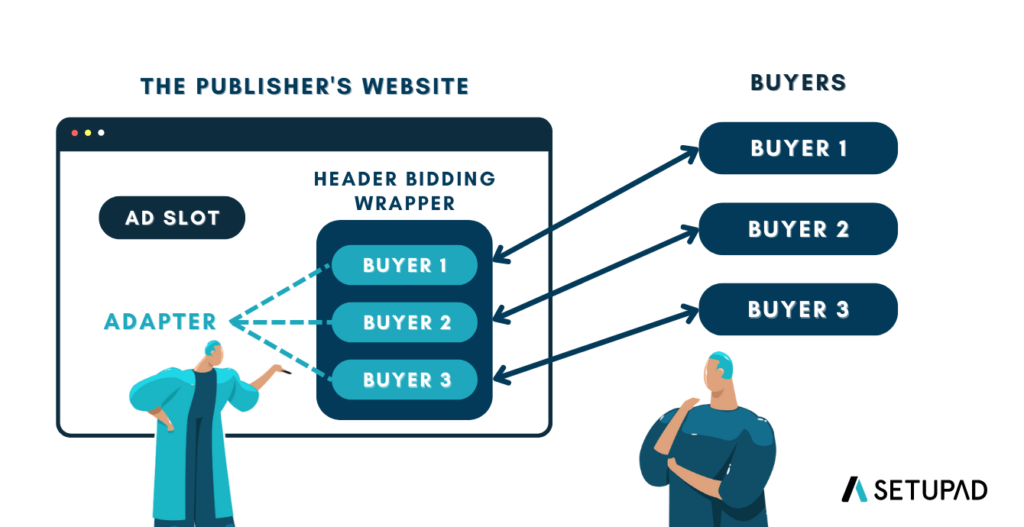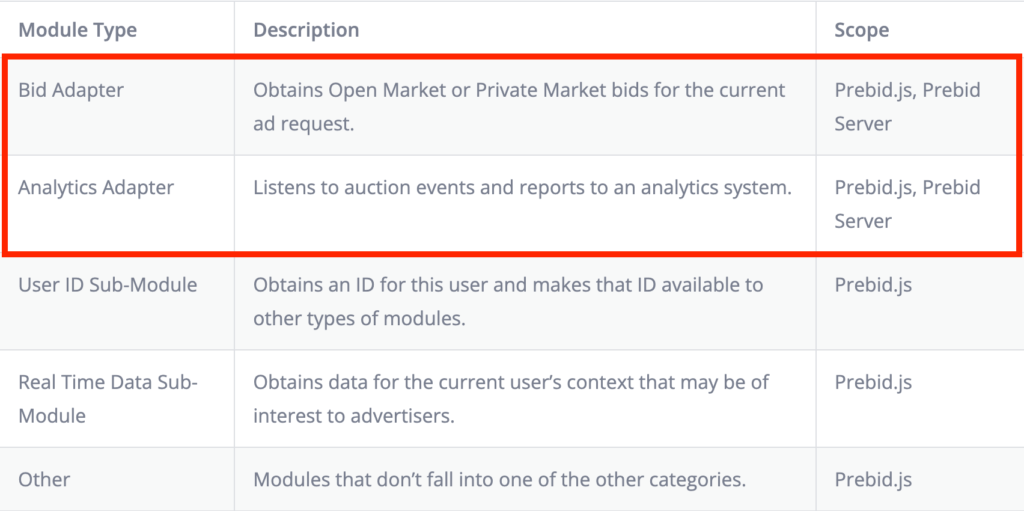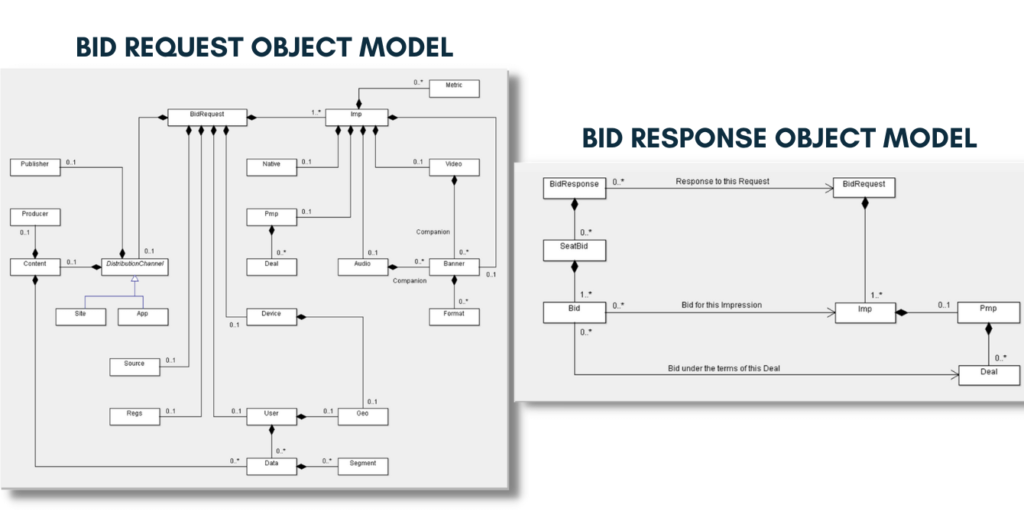What is a Prebid Adapter? | 4 Best Adapters for Publishers
Prebid adapter allows publishers to collaborate with a demand partner, as well as the agencies and advertisers it has partnered with. The adapter integrates with your header bidding wrapper to enable connection with the demand partner’s ad inventory.
This article explains what a prebid adapter is, its types, and why it’s essential for your header bidding solution.
Table of Contents:
- Recap: What is Prebid?
- What is a Prebid Adapter?
- Prebid Adapter Types
- Why Are Prebid Adapters Necessary?
- How to Add a New Prebid Adapter?
- 4 Best Adapters for Publishers
Recap: What is Prebid?
Prebid is a worldwide organization run by volunteers from the adtech industry. Together they develop a line of open-source header bidding products, simplifying the entire header bidding process for publishers.
Depending on how each ad exchange is configured, open-source wrappers are used to control the technical process of managing bid requests.
Prebid.js was designed in 2015 by AppNexus, and now it’s one of the most popular header bidding wrappers. It’s an open-source program under the Apache License embraced by the Rubicon Project in 2017.
Prebid.js simplifies the deployment of header bidding on publishers’ websites. Before it, only large publishers could afford to build complex and custom header bidding solutions, which weren’t efficient.
With prebid.js, the setup is faster and requires lower expenses.

What is a Prebid Adapter?
An adapter is a device that connects pieces of equipment that cannot be connected directly. Header bidding adapter is a piece of code, which allows the creation and processing of bid requests for a specific demand partner.
Prebid adapter helps publishers to connect with their demand (e.g., ad exchange, SSPs, or ad network). Typically an adapter is a product provided by a programmatic partner.
Prebid adapters create bid requests for the bidder’s server and analyze the bid responses (bid value and ad creative) obtained from DSPs.
Prebid.js adapters are plugins that attach to the prebid.js core, and are used interchangeably depending on the partners a publisher chooses to work with.
Why do publishers need a prebid adapter?
Prebid adapter is required to access the SSP’s demand, and the header bidding wrapper works as a container for the adapter.
If you, as a publisher, want to implement header bidding and include top SSPs (e.g., OpenX), you’d need an adapter for each partner.

Prebid Adapter Types
The core of prebid.js contains only the foundational code needed for header bidding. Any functionality that could be considered an add-on is part of a module.
Modules are optional add-on features that increase the capability of prebid. They include both prebid adapter types–bidder adapter and analytics adapter.

Source: Prebid
The prebid server adapter is a meta-adapter. It requests bids from several bidders rather than works as an actual bidder.
Prebid server receives a request for the set of auctions and executes them all on the server (server-to-server integration), responding in time for prebid.js to submit the results to the ad server. The user experiences a much better performance as a result.
Bidder adapter
Bidder adapter represents the SSPs and ad exchanges you want to work with.
Parts that make up prebid server bid adapters include but are not limited to:
- Bidder information
- Bidder parameters
- Adapter code
- Registration with the core framework
- Default configuration values
Bid adapters are responsible for translating an “OpenRTB 2.5 Bid Request” to your bidding server’s protocol and mapping your server’s response to an “OpenRTB 2.5 Bid Response”.
RTB (real-time bidding) transaction begins when a bidder receives a bid request from an exchange or another supply source.
The top-level bid request object, at least one impression object, and potentially other objects supplying impression context make up the bid request.

Source: IAB
One or more impressions, each of which represents a single ad placement, are included in an “OpenRTB 2.5 Bid Request”. A single impression may specify several sizes and/or several ad formats.
Your adapter must break the impression into many calls and merge the results if your bidding server restricts requests to specific ad placement, size, or format.
According to Prebid.org, there are more than 300 bidder adapters. Prebid.js is unique because of this collection of functional header bidding integrations.
Instead of a proprietary wrapper solution that tries to imitate another company’s adapter, each company maintains its prebid.js adapter to provide publishers with the most recent code.
Analytics adapter
Analytics adapter provides the ability to learn more about page latency, revenues, bid rates, timeouts, etc.
Prebid.js analytics data can be obtained and sent to any analytics service provider, such as Google Analytics.
Why Are Prebid Adapters Necessary?
Adapters serve as carriers to the demand side. After adding a wrapper, the bid request will go directly to the demand partner.
Once the DSP conducts an internal demand level auction, the adapter transmits a qualifying bid response to the wrapper for an additional auction.
Adapter also contains information on inventory and ad requirements (ad sizes, ad format, and ad types). This is necessary when looking for suitable ad agencies to bid on publisher inventory.
What are the most common prebid.js bid parameters?
| Bid parameters | Meaning |
| Publisher ID | A custom identifier for a publisher. |
| Ad slot | The ad unit name created on all platforms and then added to the header bidding setup. |
| Size | Sizes that are going to be used for each ad slot. It can be one or multiple. |
| Key-value | Used for targeting. Includes social demographic/user-centric data. |
| Programmatic deals | Specifies parameters for either RTB, PMP, programmatic guaranteed, or preferred deals |
| Floor price | Sets the global floor price–no bids will be made under the specific value. |
How to Add a New Prebid Adapter?
No specific setting is required to add a new prebid adapter.
You should simply include it by choosing the adapter while downloading the Prebid.js package if you want to add a new adapter, whether it is for demand or analytics.
If you already employ a managed solution provider, you can ask them to add a new adapter.
How to choose an adapter for your wrapper?
Each SSP and DSP have its own requirements with which websites and apps they work. The approval process depends on the tools and the traffic they are looking for.
The first step would be to make sure that the SSP will be able to open an account for you. Some require significant monthly traffic to cover the costs of launching a site through their platform. Many large SSPs won’t approve a website under 100m monthly impressions.
Additionally, each SSP has specific locations where its performance is the strongest. Some may focus on America, Europe, and others on India, Africa, Japan, Asia, and more.
This can be understood by reaching out to account managers of the respective platforms.
Ask them to look at your site and provide data about your visitors. It is essential only to add adapters that work well in your market.
If you are using browser-side connections, there are only so many adapters you can add before it starts to bog down the bid process and increase the timeouts, producing worse results.
The more the better doesn’t apply for the browser-side connections.
The more relevant adapters you add, the better the results.
It’s essential to understand what formats are running on the site. Only some of the formats are supported by all of the adapters. For example, native, video, or app demand might not be available on many.
If you plan to add server-side connections, ensure that the adapter you add supports it. Some may allow running server-side and browser-side simultaneously, increasing bid density.
Ensure that the adapter supports the prebid version you are using and that the system is actively updated to work with the newest version. Otherwise, it could cause issues and lead to a loss of revenue.
Ensure that the adapter can support multiple sizes for each ad unit. This will help to increase revenue – the more popular sizes are added, the better.
Check how fast their load time is and ensure they can bid well from any location if your traffic is global. If most of the traffic is local, try to add adapters focused on your market, as they could have direct deals specific to your audience location.
4 Best Adapters for Publishers
It’s challenging to determine with precision which adapter is best. It depends on a variety of factors, including website traffic, content, layout, speed, and language.
The list below shows 4 of the most common adapters. It’s based on their overall performance rather than specific markets.
1. Rubicon Project adapter
Rubicon Project is a well-known prebid partner that actively contributes to publisher revenue globally. Their adapter gives publishers access to a private market and guarantees them partnerships.
In addition to the adapter, Rubicon also provides performance statistics and a team for account management to help customers execute profitable auctions consistently despite the complexities of header bidding.
Rubicon Project adapter’s top features are:
- One of the prebid bidder adapters enables publishers to receive bids in net or gross as desired.
- Rubicon promotes SupplyChain (Schain) items that improve auction transparency.
- Demand exists for both video and display. On your inventories, you can serve both overlay and instream video advertising.
- Web publishers have access to options for custom targeting. It is possible to offer ads to mobile app users depending on their longitude and latitude (user geolocation). You can also modify and improve the bid floor price for demand-side platforms.
- The Rubicon adapter encourages compliance with data privacy rules like GDPR, CCPA, etc. Additionally, it can be integrated with most major CMPs, and it’s a COPPA-compliant adapter.
2. Criteo adapter
Criteo is one of the most popular prebid adapters. It offers sophisticated retargeting options. With demand partners, it promises to deliver transparent reporting statistics. Publishers can raise their CPMs by claiming that they can deliver unique demand.
Retargeting initiatives are Criteo’s primary area of focus. They had some issues with channel conflict, just like many other bidders did when they attempted to enter first-price bids into GAM’s second-price auction.
Most of these issues have been resolved, and publishers now place a high value on Criteo’s share of voice.
3. OpenX adapter
One of the leading companies in the programmatic advertising market, OpenX, offers a prebid adapter to assist publishers in making money from their ads through live auctions.
For programmatic deals, OpenX offers a fully optimized adapter By establishing connections between publishers and numerous DSPs and advertisers, it aims to give publishers a better CPM.
OpenX offers publishers dynamic bidding, which maximizes the value of each bid.
Additionally, it gives advertisers access to publisher inventory using audience synchronizing technology. Each auction is still within the publisher’s authority.
The key characteristics of the OpenX adapter are listed below:
- Utilizing third-party video players like JW player, the adapter can assist in making money off of display and instream video ad inventories.
- In addition to supporting TCF V2 and other US privacy laws and regulations, it complies with the GDPR, CCPA, and COPPA.
- The adapter allows you to use universal ID solution providers (e.g., Criteo) while integrating user modules into prebid. You can use them to recognize the same user on many platforms and channels.
- The bidder adapter provides the ability to establish and control price floors. In order to prevent ad inventory from being sold for less than anticipated, a publisher can set a minimum bidding price for it. Publishers have the option to eliminate the floors one at a time or as a group, if necessary.
- Publishers can limit advertisers’ usage of specific user data by using the bidder adapter in order to preserve that user’s privacy. That is done by including the “DoNotTrack” element in the bid request.
- Adapter can make it possible for demand-side platforms to synchronize users, which enhances buyer targeting and match rates.
4. AppNexus adapter
AppNexus provides a prebid adapter that is specifically tailored for prebid auctions. They also support a wide range of hardware and ad types, including native ads, mobile ads, and video ads.
With its improved prebid adapter, AppNexus, a leader in the creation of open-source header bidding, gives publishers access to a distinctive, varied, and substantial demand.
With impressions from all tiers, medium to large publishers may effectively monetize their inventory. The total performance is exceptional in both bid rate and win rate.
AppNexus adapter allows to:
- Monetize display and video (instream and outstream) ad inventories. Additionally, it might assist you in generating native ad demand. If you have an app for your website, you can use the AppNexus adapter to monetize the app inventories.
- The adapter complies with GDPR, COPPA, and CCPA and abides all applicable privacy laws and rules.
- In prebid, the adapter supports the Schain object. Therefore, the sale of ads will be more transparent.
- For banner and video advertisements, it provides key-value targeting and bespoke targeting options. Keys can be defined both with and without values (in order to dynamically add them later).
- Criteo’s user ID module can be linked with AppNexus’ adapter. So you can better target users and show them relevant ads by utilizing Criteo’s database and synchronizing users.
- Publishers can specify a floor price for the bids that demand-side platforms return in the auction.
- You can turn on advanced debug auction for AppNexus auction diagnosis to learn more about what is happening during auctions.
Why choose Setupad?
If you’re looking for a way to maximize your ad revenue and streamline your ad operations, Setupad Prebid technology might be your solution. Our technology is preconfigured, adapters are provided to connect with existing publishers’ GAM and SSP accounts, and the ad revenue is directly paid to the publisher from demand partners.
Our header bidding wrapper is fully optimized with Google, and we provide publishers with access to Google AdX through GAM and the demand of all header bidding partners at no extra cost.
Setupad’s hybrid header bidding wrapper includes server-to-server integrations to the Prebid server, Amazon’s TAM, and Google’s Open Bidding, which account for at least 35% of the winning bids.
Sign up with Setupad today to see how we can help you take your ad revenue to the next level!

Conclusion
When running header bidding auctions, publishers have to use prebid adapters. Before selecting a new adapter, you should be cautious and examine its features, including compatibility with other prebid adapters.
As a publisher, you should be aware that adding multiple adapters can boost fill rate and revenue, but it can also increase page latency. In order to reach the highest efficiency with prebid adapter or other prebid products, you should always perform tests.
FAQs
What is Prebid Adapter?
Prebid adapter helps publishers to connect with their demand. Prebid adapters create bid requests for the bidder’s server and analyze the bid responses obtained from DSPs.
What is Prebid vs post-bid?
Prebid is the evaluation of ad impressions before serving, while post-bid involves filtering ads after they have been served. Prebid optimizes bidding, while post-bid controls delivered ads.
How do I add an adapter to Prebid?
To add an adapter to Prebid, you need to select the desired compatible adapter, install and configure its code following Prebid guidelines, register the adapter, configure settings, test integration, and deploy the updated Prebid code.
What is the function of Prebid?
Prebid facilitates header bidding, maximizing ad revenue for publishers by allowing simultaneous bidding from multiple demand sources. It optimizes ad monetization, enhances competition among advertisers, and provides transparency and control over ad auctions.
Is Prebid an ad exchange?
Prebid.js operates on the client-side, conducting auctions and decision-making within the user’s browser. It’s not an ad server but a tool that can be used alongside an ad server like Google Ad Manager.
How do I know what version of Prebid I have?
You need to open your browser console and type pbjs.version to see what version of Prebid.js you’re using.


